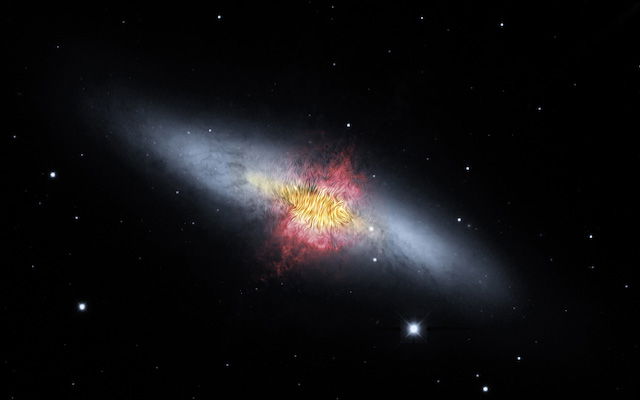
A new study has shown new clues to the evolution of The Cigar Galaxy (also known as M82).
The Cigar Galaxy is a starburst galaxy, meaning it has an extraordinary speed in making new stars.
Previously, scientists have found that stars are born 10 times faster in the Cigar Galaxy than in the Milky Way.
In order to form newborn stars, the parent galaxy has to hold a large reservoir of gas, which is slowly depleted to spawn stars over time.
For galaxies in a state of starburst, this intense period of star formation has to be triggered somehow — often this happens due to a collision with another galaxy.
Another interesting feature of the Cigar Galaxy is that it also has strong winds blowing gas and dust into intergalactic space.
Researchers supposed these winds would also drag the galaxy’s magnetic field in the same direction, but there is little evidence for the view.
In the present study, the researchers used the data from the Stratospheric Observatory for Infrared Astronomy, or SOFIA to study the galaxy evolution.
SOFIA is a Boeing 747SP jetliner modified to carry a 106-inch diameter telescope.
They found the galactic wind from the center of the Cigar Galaxy is aligned along a magnetic field.
The wind drags the magnetic field more than 2,000 light-years across and it is perpendicular to the galactic disc.
With the High-resolution Airborne Wideband Camera-Plus in SOFIA, the team could infer the shape and direction of the otherwise invisible magnetic field.
The HAWC+ instrument was developed and delivered to NASA by a multi-institution team led by the Jet Propulsion Laboratory.
The galactic wind could deliver a very large mass of gas and dust with the equivalent mass of 50 million to 60 million Suns.
The gas and dust are the basic material for stars and galaxies to form.
The researchers suggest that if similar processes occurred in the early universe, they would have affected the fundamental evolution of the first galaxies.
Their findings are important for understanding how galaxies evolved over the history of the universe.
One study researcher is Terry Jones, professor emeritus at the University of Minnesota, in Minneapolis.
The research is published in Astrophysical Journal Letters.
Copyright © 2019 Knowridge Science Report. All rights reserved.



